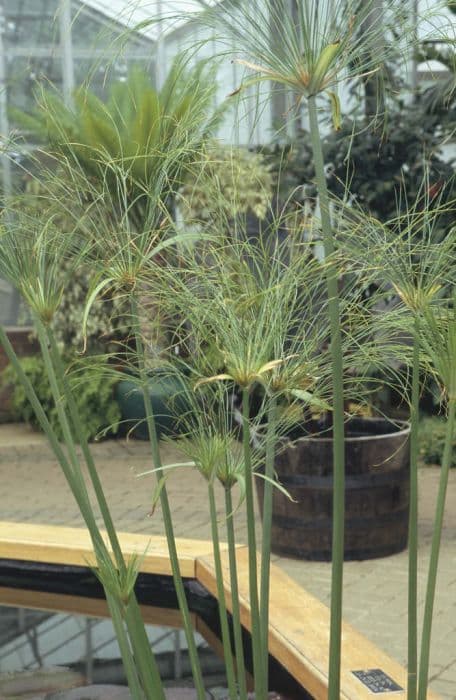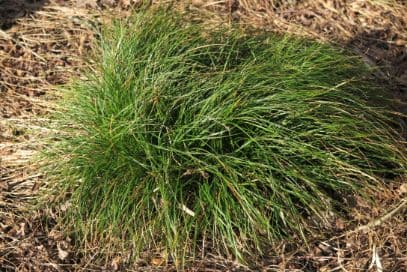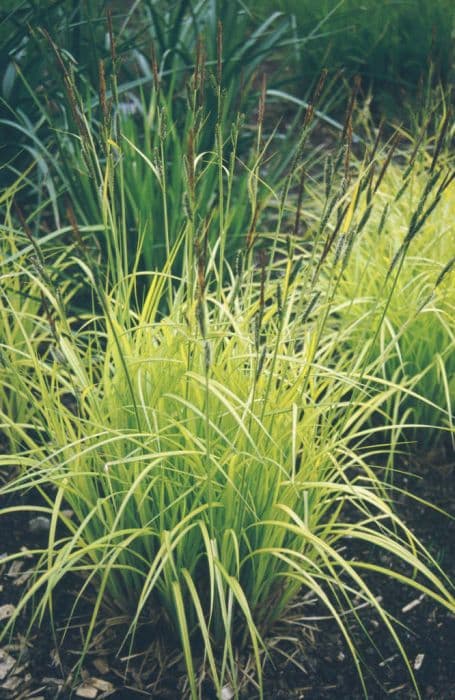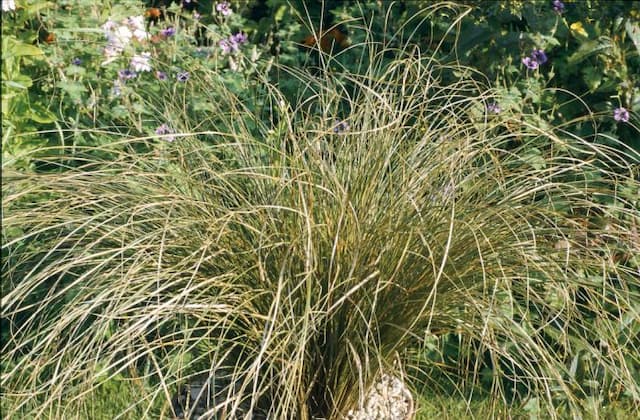Papyrus Cyperus papyrus

ABOUT
Cyperus papyrus, commonly known as papyrus, is a lush, water-loving plant with a distinctive growth habit. Its thick, triangular stems emerge upright from the base of the plant, conveying a strong architectural look. Atop these stems are bushy tufts of thin, hanging threads which form a graceful, umbrella-like spray that resembles a plume or a fireworks burst. This characteristic crown gives it a very ornamental appearance that catches the eye. The stems of papyrus are bright green and they contrast beautifully with the feathery tufts, which can range from green when young to a straw-like color as they mature. The green stems are spongy and buoyant, which historically made them useful for a variety of purposes. Among the stems, you can sometimes find small, inconspicuous brownish flowers which are not very prominent. The plant's leaves are reduced to sheaths that wrap around the base of the stems. In their natural wetland habitats, papyrus plants cluster together forming dense stands, which create a dramatic and lush vista. The overall visual impact of papyrus is one of lightness and soft texture, with its plumes swaying gently in the breeze, providing a peaceful and serene display of nature's elegance.
About this plant
 Names
NamesFamily
Cyperaceae
Synonyms
Egyptian Paper Reed, Egyptian Papyrus, Papyrus, Papyrus Sedge, Paper Reed, Nile Grass, Indian Matting Plant, King Tut's Reed
Common names
Cyperus papyrus, Chamærops humilis var. papyrus, Cyperus candelabrum, Cyperus dives, Cyperus giganteus, Cyperus papyrus var. humilior, Cyperus papyrus var. prolifera, Cyperus syriacus, Cyperus juncifolius, Kentrophyllum papyrus, Papyrus antiquorum, Papyrus latifolius, Papyrus officinalis.
 Toxicity
ToxicityTo humans
Papyrus is not known to be toxic to humans. There are no significant reports of poisoning from ingestion of this plant, and it has historically been used in various applications, including paper-making and as a craft material without evident adverse health effects from handling or incidental ingestion.
To pets
Papyrus is not considered toxic to pets. It does not contain any known toxic compounds that would pose a risk to dogs, cats, or other domestic pets if they nibble on its leaves or stems. Nevertheless, ingestion of non-food items can sometimes cause gastrointestinal upset in pets, so it's advisable to keep an eye on your pet and consult a veterinarian if any unusual symptoms occur after ingestion.
 Characteristics
CharacteristicsLife cycle
Perennials
Foliage type
Evergreen
Color of leaves
Green
Height
5 feet (1.5 meters)
Spread
2 feet (0.6 meter)
Plant type
Sedge
Hardiness zones
9
Native area
Africa
Benefits
 General Benefits
General Benefits- Erosion control: Papyrus plants have extensive root systems that can help stabilize soil and prevent erosion near bodies of water.
- Wetland habitat: They provide an essential habitat for wildlife, particularly in wetland ecosystems, supporting a variety of birds, amphibians, and insects.
- Water treatment: Papyrus has the ability to uptake and assimilate nutrients from wastewater, contributing to natural water treatment processes.
- Cultural significance: Historically, papyrus was used by ancient Egyptians to make paper, boats, mats, and ropes, which has considerable historical and cultural value.
- Ornamental use: With its distinctive, tall, and feather-like appearance, papyrus is popularly used in ornamental water gardens and landscape design.
- Craft material: Papyrus stems can be used for making paper, as well as for craft materials in basket weaving and other traditional handicrafts.
 Medical Properties
Medical Properties- Anti-inflammatory: Papyrus is traditionally used to reduce inflammation.
- Wound healing: In folk medicine, papyrus sap has been applied to wounds to promote healing.
- Diuretic: It is believed to have diuretic properties, which can help in increasing urine production.
- Antioxidant: Papyrus may contain compounds that possess antioxidant properties.
 Air-purifying Qualities
Air-purifying QualitiesThis plant is not specifically known for air purifying qualities.
 Other Uses
Other Uses- Craft Material: Papyrus stems can be used to make mats, baskets, sandals, and even small boats, as they are buoyant and can be woven or tied together.
- Artistic Medium: Artists may use slices of papyrus as a canvas for painting, due to its natural texture and historical significance.
- Thatching Material: The stalks of the papyrus plant have traditionally been used for roofing in some African homes.
- Culinary Use: In some cultures, the pith of the papyrus plant is edible and can be used as a source of starch.
- Furniture: Dried and treated papyrus can be crafted into furniture items such as chairs and tables.
- Paper Production: While not as common nowadays, papyrus can still be processed into a rudimentary form of paper for educational or decorative purposes.
- Historical Demonstrations: Papyrus is used in historical recreations to demonstrate ancient writing and record-keeping techniques.
- Floral Arrangements: The attractive flowering heads of papyrus can be used in dried floral arrangements and displays.
- Fencing Material: Bundles of papyrus stalks can be used to create natural-looking fences and garden borders.
- Fuel Source: Dried papyrus has been used as a fuel for fires where other resources are limited.
Interesting Facts
 Feng Shui
Feng ShuiThe Papyrus plant is not used in Feng Shui practice.
 Zodiac Sign Compitability
Zodiac Sign CompitabilityThe Papyrus plant is not used in astrology practice.
 Plant Symbolism
Plant Symbolism- Enlightenment: Cyperus papyrus, commonly known as papyrus, symbolizes enlightenment as it was used to produce paper for writing, thus spreading knowledge and wisdom.
- Prosperity: In ancient Egypt, papyrus was a symbol of prosperity due to its association with the fertile Nile Delta, where it grew abundantly.
- Eternal life: Egyptians used papyrus in the burial process; its durability and evergreen nature were seen as symbols of life after death.
- Interconnection: The complex root system of papyrus is often seen as a symbol of the interconnectedness of life and the environment.
 Water
WaterThe Egyptian Papyrus, commonly known as Papyrus, prefers consistent moisture and should be watered thoroughly whenever the top inch of soil appears dry. Ideally, this plant thrives in standing water, making it perfect for water gardens or pots without drainage holes. When grown in containers with drainage, it may need water as frequently as every two to three days, especially in hot weather. Provide the plant with approximately one to two gallons of water each time you water, ensuring that the soil remains evenly moist but not waterlogged. During winter, reduce watering to match the plant's slower growth rate.
 Light
LightPapyrus plants prefer full sun to partial shade to thrive. The best spot for a Papyrus plant would be a location that receives at least four to six hours of direct sunlight each day, such as a spot near a bright window indoors or in a sunny area of the garden outdoors. They can tolerate some shade, but too little light may cause the plant to grow less vigorously.
 Temperature
TemperaturePapyrus plants do well in warmer temperatures and should be kept in an environment where the temperature ranges between 50 and 90 degrees Fahrenheit. They can survive temporarily outside this range, but growth will be affected if temperatures drop below 50 degrees Fahrenheit or exceed 90 degrees Fahrenheit. The ideal temperature for Papyrus is between 70 and 85 degrees Fahrenheit.
 Pruning
PruningPruning Papyrus plants is mainly done to remove old or yellowed stems to maintain an attractive appearance. Pruning can be done as needed throughout the year, but it is best performed in the spring before new growth begins. Cut the stems near the base of the plant, and aim to prune back only about one-third of the plant to avoid stress. This also encourages more vigorous and healthy growth.
 Cleaning
CleaningAs needed
 Soil
SoilPapyrus plants thrive in a soil mix that is consistently moist and has good drainage. A combination of two parts peat, one part loam, and one part sand can be ideal. This plant prefers a soil pH of around 6.0 to 7.5.
 Repotting
RepottingPapyrus plants should be repotted every 1 to 2 years to refresh the soil and accommodate root growth. It is best to repot in the spring or early summer.
 Humidity & Misting
Humidity & MistingPapyrus plants, also known as paper reed, prefer high humidity levels, typically over 50%. They thrive in moist, humid environments which mimic their natural habitat near water.
 Suitable locations
Suitable locationsIndoor
Place papyrus in bright, indirect light and keep the soil moist.
Outdoor
Plant papyrus in full sun to partial shade in wet areas.
Hardiness zone
9-11 USDA
 Life cycle
Life cyclePapyrus, Cyperus papyrus, begins its life cycle with the germination of seeds which require warm temperatures and wet conditions to sprout. Seedlings emerge and develop into young plants with distinctive tall, thick, triangular stems and feathery plumes at the top. As it matures, Papyrus forms dense clumps through its rhizomatous root system, which helps to stabilize the plant in its aquatic or marshy environment. The plant reaches full maturity in approximately one to two years, producing brownish flower clusters that are subtended by bright green bracts. After pollination, which is typically carried out by wind, the flowers produce small, dry fruits containing the seeds. Once matured, these seeds disperse to the surrounding environment, continuing the life cycle of the Papyrus.
 Propogation
PropogationPropogation time
Spring to Summer
Cyperus papyrus, commonly known as papyrus, is a plant that is typically propagated through division. The best time to propagate papyrus is during the warmer months when the plant is actively growing, usually in late spring through early summer. To propagate by division, a mature papyrus clump is taken out of the water or potting medium and the root mass is cut into sections, each with a portion of the rhizome and some top growth. These sections are then replanted in a watery or consistently moist environment where the ambient temperature is warm. It is crucial that the divisions are kept very wet, which simulates the plant's natural habitat along riverbanks and in marshy areas. Transplanted divisions will root and establish themselves, producing new growth in due course. This straightforward method allows for a quick increase in the number of plants.









